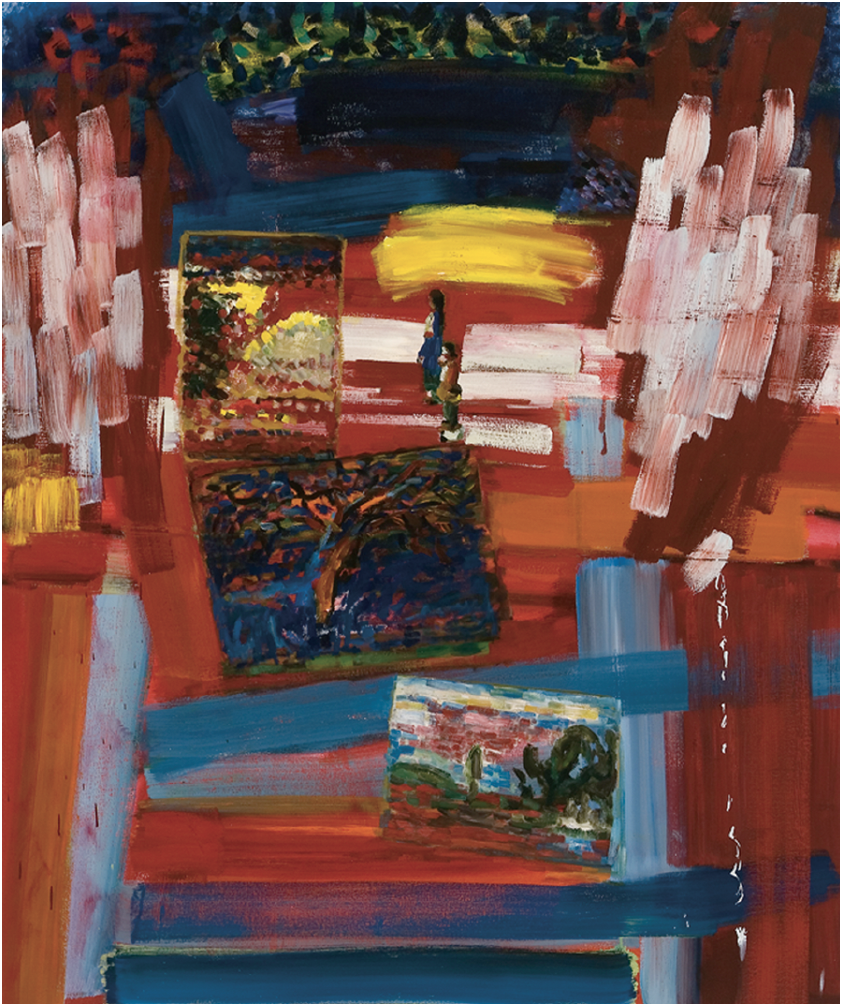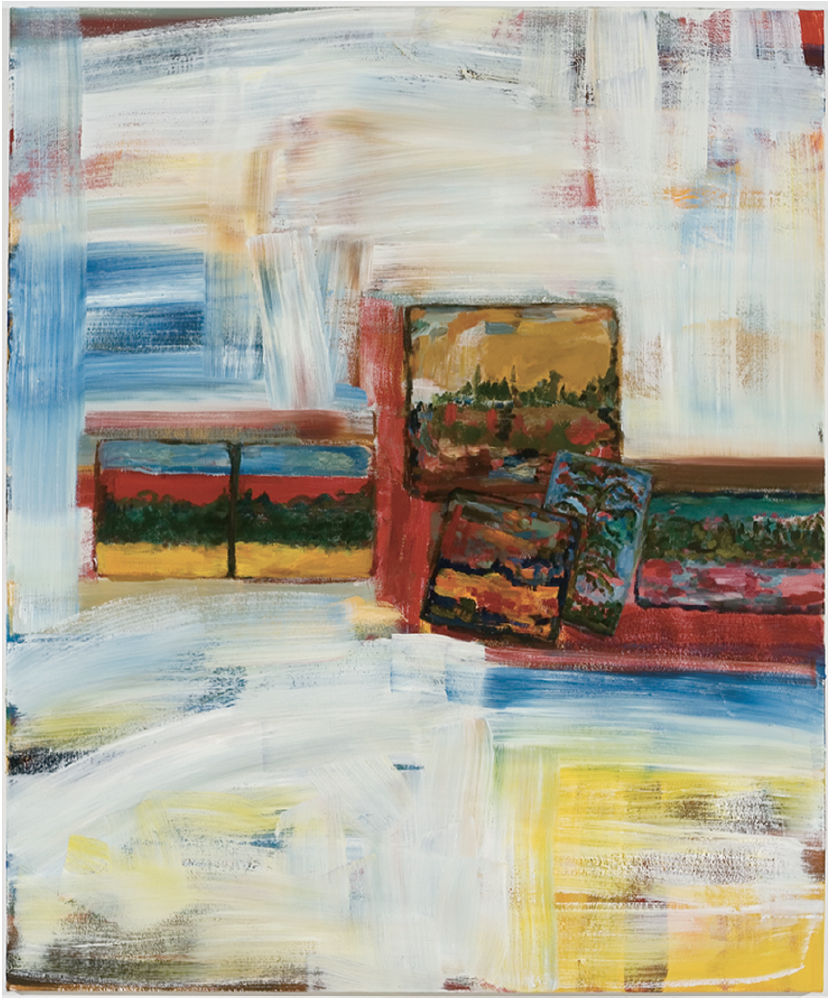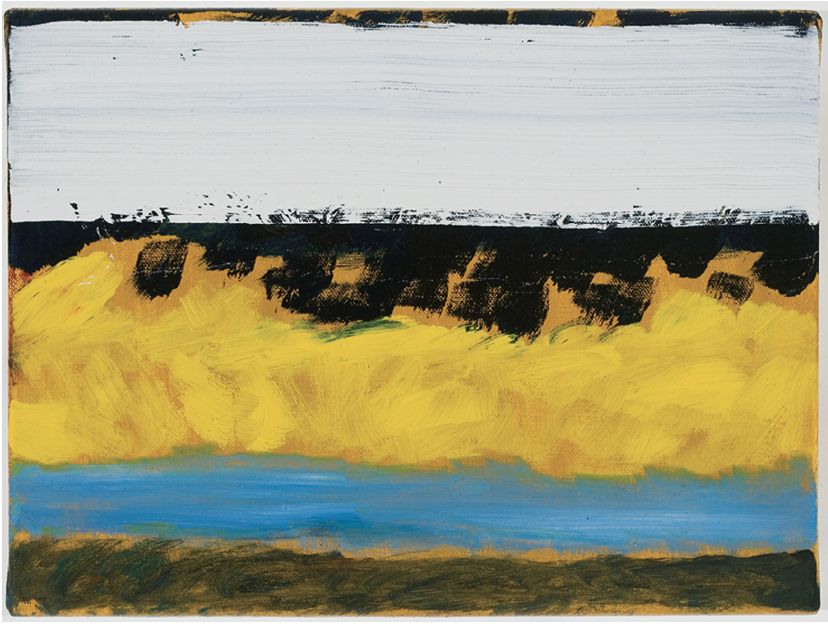Gina Rorai
The claims that Gina Rorai has reached a pinnacle and is in the painting game for the long haul are proved beyond a doubt in her recent paintings. The signature vivacity that can be felt in every square inch of surface stems from desire and its methodical amplification in pure painted matter. Bolder, more expressive than before, these luminous fields of pure chroma stake their claim on us.
Rorai’s signature repertoire of lovingly applied representational painting terms and abstract phraseologies is still present. Even magnified, now. Similarly, her Persian miniature-like paintings- within-the-painting are mostly still here. The little nature mortes, landscapes and figures have always read as being both vital and necessary, rather than incidental detail in this work, and that has not changed. Bravura paintwork and exuberant daubing entice us into these surfaces with their wealth of indexical markings, and effortlessly hold us there between the abstract and the representational as we survey their densely packed and field structures at close quarters.
Stray impressions of seismic tremors in these new paintings, as reported by some critics, are somewhat misleading, I think, for there are no fault lines in them. Making it new in painting, after all, does not necessarily mean birthing fashionable discontinuities or performing stylistic pirouettes. The foundational integrity of these paintings, as is the case with all her work to this date, is Gibraltar-rock solid.

Gina Rorai, Starless, 2007, oil on canvas, 72 x 60”. All photographs courtesy Birch Libralato, Toronto.
What has changed is the presence of larger, more declaratively rendered brush strokes, which are poised laterally, vertically and diagonally in truly vectorial fashion across the better part of the original plane and which contribute to the pyrotechnics. This is the case in The Last Day, 2007, where a blizzard—a proverbial whiteout—of wide white strokes seize the day, and Starless, 2007, in which clusters of strokes reach upward like Roman candles. But is this a sea change, really? Or is it an idea of internal order that was broached over 10 years ago in paintings like First Night, 1996, with its vertical veil/sieve/sleeve band of magenta that permeably overpaints and enshrouds at least a third of the plane?
In her new work, Rorai is at once looking backward and forward, as any painter worth his or her salt at a certain level of accomplishment is deeply entitled to do. No question, the work is evolving—and at its own measured pace. She is moving strongly into the abstract arena now. But that is also not without clear precedent in her corpus. She has always been a restless spirit.
In the larger paintings, there is a host of volumetric constellations of paintwork that should not—well, at least not in principle— work in concert. These new paintings, by their very nature and multiplicity, argue against formal cohesion, and yet they achieve a cohesion and coherence that are unavoidably chromatic as well as structural in character. The paintings never come undone and that is a tribute to Rorai’s sensuous enjoyment of pure chroma for its own sake— her ability to slowly coax sense out of sundry colours and their juxtapositions—and also to her considerable dovetailing skills. Wide swaths of abstract gestural passages accentuate the sheer wealth of minute painterly detail that has always been a hallmark of her work. But they do not constrain, direct or in any way obviate it. What seems at first like outright cancellation or erasure is really demarcation, heightened emphasis, highlighting.

Gina Rorai, The Last Day, 2007, oil on canvas, 72 x 60”. Collection BMO Financial Group, Corporate Art Collection.
The paintings are very much themselves; each painting has its own distinctive and unfettered auratic life. We sense the weight of her history behind every brush stroke and this buoys up the paintings rather than pulling them down. This is a testament, of course, not just to her natural intimacy with pigment but to just how intuitively sound her painting decisions are and to her ability to bring it all under fluent command and fluid control.
She drops into the plane, with loving and elliptically subtle riffs on details and licks from paintings by Jean-Baptiste- Camille Corot, de Kooning, Pierre Bonnard, Matisse, and the Quebec school whose work she so reveres: Paul-Émile Borduas, Jean-Paul Riopelle, Jean McEwen and others. I thought I saw a glancing reference to the watercolours of Gershon Iskowitz, as well. This has to do with force of painting belief and “working through” rather than explicit homage, of course. No earnestness or yearning—just plain old love of great painting. For instance, in Island, 2006, the painter’s arabesques remind us of just how much a red Algerian carpet meant to the post- Fauve Matisse—and precisely why it means so much to Rorai. This work is all about the act of painting, the sanctity of paint and the moral authority of the act, processual dynamics hidden in plain sight—and a fiercely held belief in the supremacy of making; the righteousness of a painter devoted to pigment, unchecked, inviolate and always a centre post in painting’s way.
The linchpin (one among many, really, but this most telling) is undoubtedly For C.B., 2007, a comparatively small, achingly reduced painting—the scale of which is belied by the girth of the white lateral brush stroke that sweeps across its upper quadrant—and is all the more unyielding in its beauty for being so wide and so confidently wrought. The overall painting reduction, with its varied applications of paint in horizontal zones, reads like the purest of painterly distillations, each zone having its own unique idiom, personality, soulfulness, which slowly accrete sense to the whole. With its lateral exhalations and variegated applications of paint in stacked, horizontal registers—it is all about the alchemical process of painting itself.

Gina Rorai, For C.B., 2007, oil on canvas.
Of particular interest to both diehard fans of painting and newcomers alike is the dialectical nature of Rorai’s interleafing. Each constellation or collocation of marks in these paintings speaks to its neighbour of unity and a progressively calibrated palette, of possibilities and self-presence, of the differential threshold of paint on canvas.
Gina Rorai is an artist always poised to speak her painting mind. For her, the stakes are simply too high to keep mum, dumb it down or, god forbid, play it safe. She has earned the privilege—and the right—to do it her way. She is a risk taker and a tightrope walker who never looks down and never loses her resolve. She walks a line between abstract gesture and represented thing; between the sign and the trace; between a palimpsest of markings and the simplest strike. Within the parentheses of this edifying and exacting dialogue, she stakes her claim and ineluctably draws the viewer’s eye to her paintwork. ■
Gina Rorai’s “The Obliterati” was exhibited at Birch Libralato in Toronto from February 17 to March 17, 2007.
James D. Campbell is a writer and curator based in Montreal.

